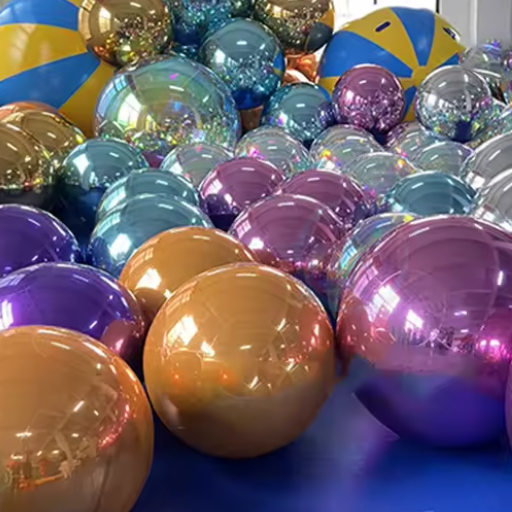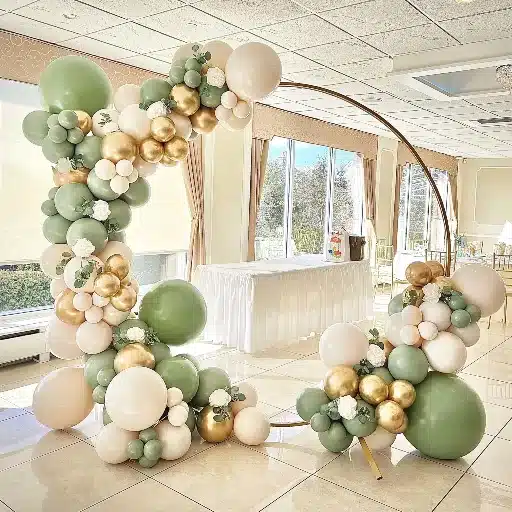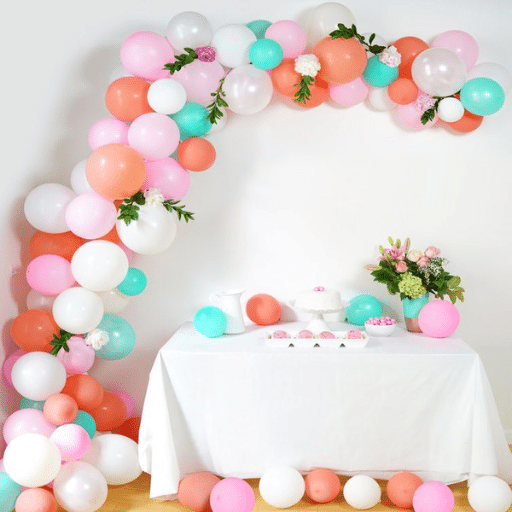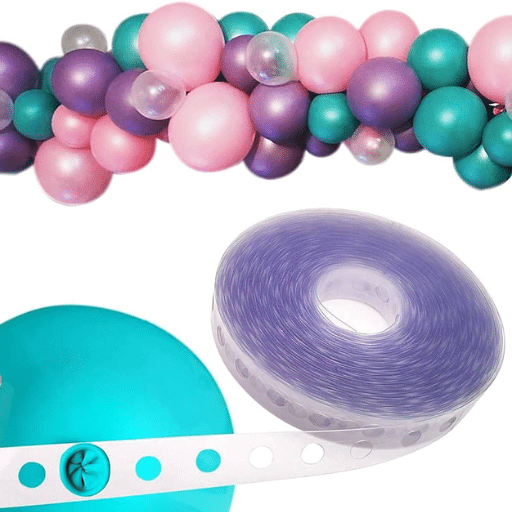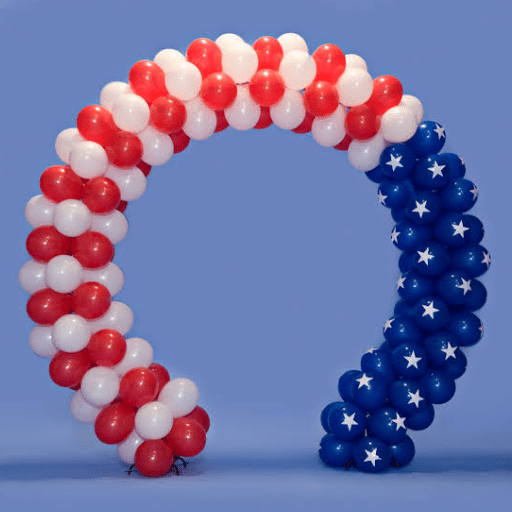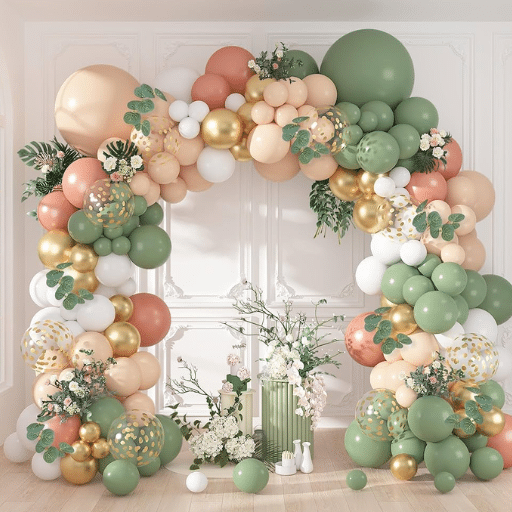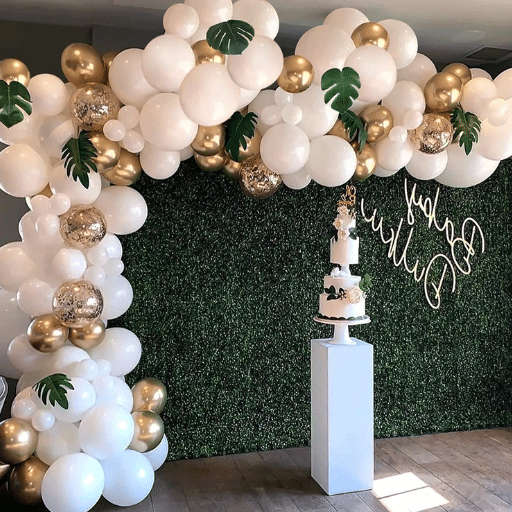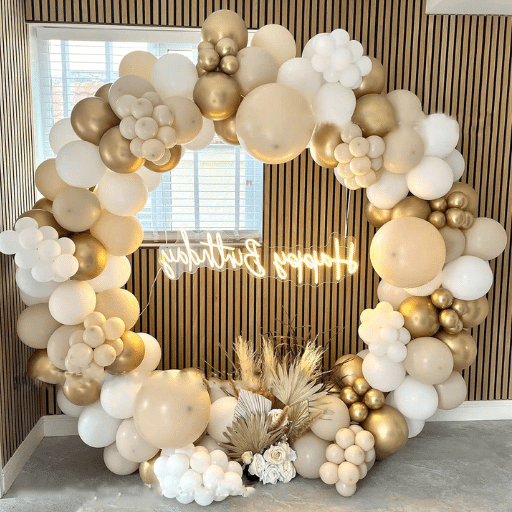A beautiful balloon arch ties the whole event ambience from birthday parties and weddings to corporate events. But then comes the question in the heads of organizers and hosts—how long will it last? This blog is your complete guide on durability and lifespan of balloon arches. Whether you’re thinking of setting an arch indoors or outdoors or looking for the best materials and techniques to make sure it stands through your celebration, we’ve got everything in store for you. Read on to find out exactly what you need to secure your balloon arch as a lasting focal point for any of your special events!
Introduction to Balloon Arches
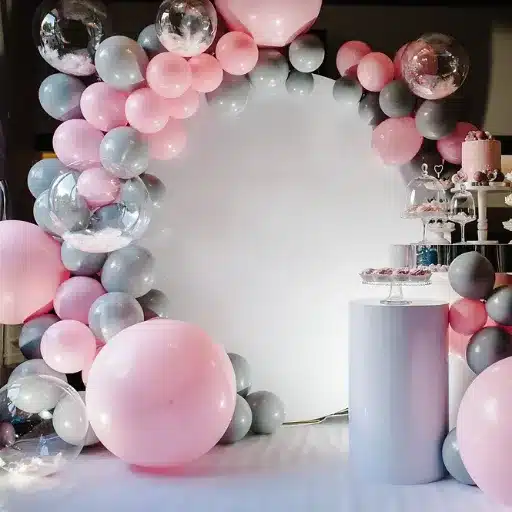
A balloon arch-based decorative installation is created by arranging balloons in a curved or arch-like shape to emphasize events invited by weddings, birthdays, corporate meetings, and grand openings. Balloon arches come handy, of course, in any number of designs, sizes, and colors as per the theme of the occasion. Apart from being a point of attraction, they serve as good backdrops too for photo sessions and entrance marks.
Modern balloon arches can be constructed via several techniques, including but not limited to air or helium-filled balloons, with the frame usually made of PVC pipes or metal rods. An early trend constituting the party industry is the organic balloon arch. These arches are composed of balloons of various sizes and shapes to create a somewhat irregular and extravagant look.
Weddings and Anniversaries
Balloon arches remain popular wedding elements that create such a lofty atmosphere. They typically serve as a backdrop for the ceremony or the photo area. More than 60 percent of wedding coordinators agree that balloon installations are an economic yet really good way to enrich wedding décor, according to recent surveys. Using biodegradable or premium quality balloons, arches can fit right into the current trend of eco-friendly weddings.
Corporate Events And Grand Openings
Balloon arches are often utilized by companies for branding and promotional activities, such as product launches, trade shows, or store openings. Research has shown that striking décor elements such as balloon arches in brand colors can increase foot traffic by 30% during grand opening events. Customized designs may include logos or even mascots to enhance brand identity better.
Birthday Celebrations
Balloon arches add to the celebratory feel, whether from a child’s birthday party or a milestone celebration. For events concerning children, a few possible umbrella themes could be unicorns or superheroes. According to Pinterest, searches for themed balloon decorations rose by 45% year-on-year, underpinning their ever-increasing popularity.
Factors Affecting the Lifespan of Balloon Arches
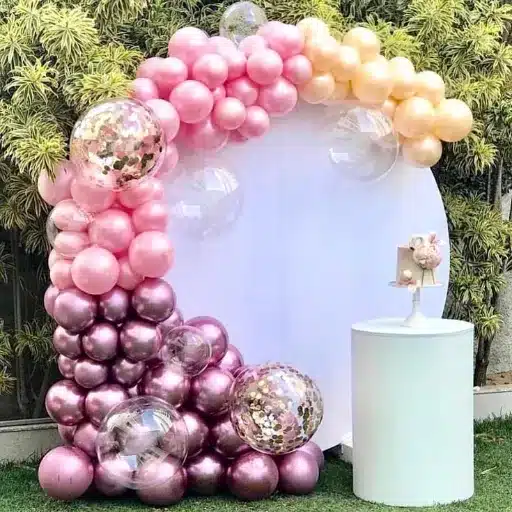
Type of Balloons Used
The kind of balloons used on a balloon arch dictates to a great extent its lifespan and appearance. Naturally, latex balloons are often considered the flexible, cheapest option with an array of colors and sizes to choose from. However, normal latex balloons more often than not do not last very long as they become prone to oxidation-especially under direct sunlight or high humidity. A balloon from the brand Qualatex can usually last a little longer than an ordinary latex balloon.
Foil balloons, otherwise being less flexible and being more prone to being affected by heat and moisture, will at times keep their shape for weeks if used indoors. They are rarely used in complicated arches because of that stiffness. According to industry experts, extending the life of indoor arches for more than two weeks is possible by using high-quality latex balloons combined with balloon sealants that prevent oxidation; and for outdoor installations, UV-protection sprays would inhibit the degradation of color brightness and structure of balloons caused by UV radiation.
Environmental Considerations
In planning events with balloon decorations, environmental impact assessment is recommended. Though biodegradable latex balloons are a step toward sustainability, they do have their drawbacks. Some researchers found that latex balloons, under certain conditions like temperature and exposure to sunlight, could take anywhere between 6 months and 4 years to decompose completely. This poses another kind of risk to wildlife and ecosystems-balloons processed into debris form may be inadvertently ingested by animals.
Heliuming further contributes to environmental concerns while being another option for balloon decorations. It is a non-renewable resource found in limited quantities on Earth. Extraction and wastage of helium for trivial matters like balloon inflation have been chastised as usages of this vital gas needed by medical technology and scientific research. Publications state that while with increasing helium demand, this action is setting the stage for possible shortages in many industries.
Materials Affecting Durability
Due to the materials used, I deem balloon decorations highly durable. Latex balloons are biodegradable but have less durability than foil balloons, which may endure for months yet definitely do not take into consideration environmental safety. So choosing materials becomes the most crucial factor in balancing between durability and sustainability.
Air-Filled and Helium Balloons

1. Lifespan:
Generally speaking, air-filled balloons tend to stay around longer compared to helium balloons. Since helium is less dense than air, helium balloons can float to some extent. However, the small molecules of helium can disperse through the surface of the balloons quicker. On average, helium balloons stay inflated 8 to 12 hours for latex and up to a few days for foil, whereas air-filled balloons last weeks if properly sealed.
2. Cost:
Being a scarce natural resource, helium is expensive. This price gets passed on to those inflating the balloon with helium. While air is free and plentiful, thus air-filled balloons turn out to be cheaper, with great consideration for large decorations such as balloon arches or walls.
3. Safety:
Though helium balloons look eye-catching, their use is marred by various safety concerns. Both by-passing the atmosphere and falling back on Earth, they pose harm to wildlife and contribute to littering. The helium gas, itself, is flammable under some conditions. Air-filled balloons, on the other hand, are much safer since they won’t float away and cause any environmental problems.
Quality of Balloon Materials

The very nature of balloon materials is key to the durability of the decorations and also to their successful operation. The two famous materials used for making balloons are latex and mylar (foil). Latex balloons are biodegradable and made of natural rubber; hence they are environmentally friendly. But they do not last long; either they lose helium or degrade within a very short time, especially when subjected to the intensity of sunlight or an extremely high or low temperature. While mylar balloons are made of polyester-type materials and are, therefore, highly durable against any form of stretching or tearing, making them great for the durability of displays. However, they cannot decompose in nature.
| Balloon Type | With Helium | With Air |
|---|---|---|
| High-Quality Latex | 12-24 hours | A couple of days |
| Mylar (Foil) | 1-2 weeks | Several months |
According to recent industry reports, high-quality latex balloons can stay inflated for 12 to 24 hours with helium, whereas air-filled versions last a couple of days. Mylar balloons trade helium for air, which they hold for about one to two weeks, while air-filled Mylar designs can go for months if under appropriate conditions. Premium grade balloons are considered thicker and less prone to leakage or popping than cheaper fare. Event planners need to weigh such factors, along with supplier reputation and product certifications, when choosing balloon materials for their events. Investing in high-quality balloons should enormously contribute to an enhanced visual appeal that prevents deflation at an early stage.
Environmental Factors to Consider
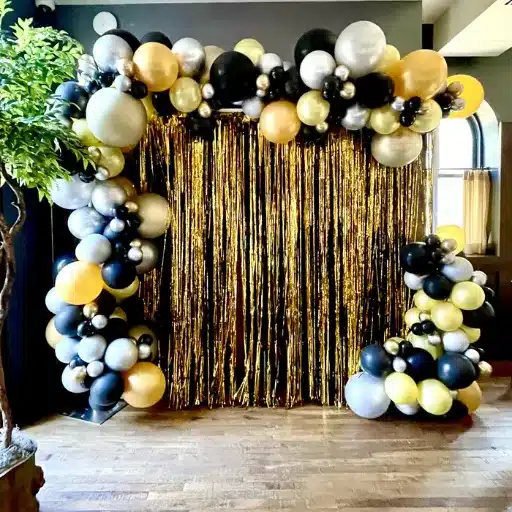
When considering the environmental factors, I always include temperature, humidity, and exposure to direct sunlight in the venue. All these parameters greatly reduce balloon durability and affect their color. High heat, for example, fosters the balloons’ expansion and bursting, whereas longer exposure to sunlight causes fading.
Temperature and Humidity Effects
The very critical environment in weather and humidity for the endurance and appearance of balloon decorations, especially balloon arches. Balloons are super-sensitive to extreme heat or extreme cold and fluctuation of humidity. High temperature makes the balloons expand and thus pop. It is however established that latex balloons lose their elasticity and start to pop at temperatures exceeding 86°F (30°C). Cold temperatures could make the balloons shrink and lose their bright colors, thus becoming brittle.
Humidity also affects balloons’ longevity. High humidity leads to moisture droplets sitting on the surface of balloons; these droplets can cause them to discolor and also oppose the reduction in lifespan. On the other hand, low humidity dries balloons, causing them to tear or deflate. Industry experts say that for balloon installations, the best environment to keep in mind is 20-22°C (68-72°F) and RH of about 50%. Under such conditions, balloons retain their elasticity, color, and shape.
Sun Exposure and Winds
Direct sunlight incidence shall greatly affect the working life and appearance of balloons. UV rays cause the degradation of the latex material over time, weakening it to eventual bursting. Balloons exposed to sunlight may lose their color or develop stickiness as the integrity of the material gets compromised. Studies show that even a short exposure time of 20-30 minutes under intense ultraviolet conditions may affect balloons adversely. Keeping this in mind, maintaining balloon installations in the shade or under UV-protective materials can help retain their quality.
Wind conditions are a threat that balloon displays face. The strength of the winds can push balloons against the structure or against themselves; hence the aesthetic value is lost. Higher than 15 mph (24 km/h) winds can disrupt outdoor decoration and endanger its stability. Balloons are best secured with weighted bases or tethering lines and made using wind-resistant designs to keep the hazards to a minimum. Event planners must check forecasts at the location and consider precautionary measures to counteract wind and sun exposure that might diminish their display.
Tips for Extending the Life of Your Balloon Arch
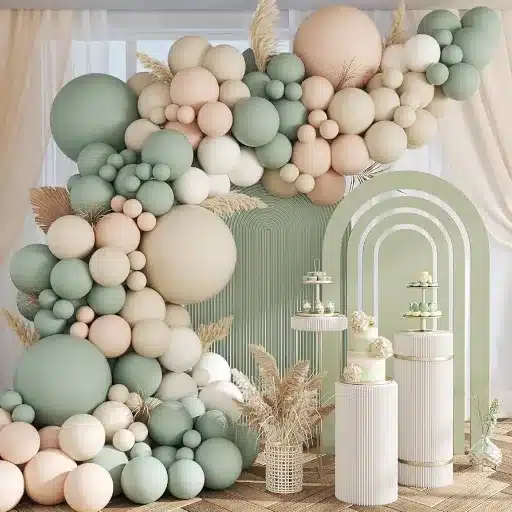
Proper Setup Techniques for Balloon Arches
First and foremost is the stability of the arch, so a good choice of frame is important. The frame should be fabricated from strong and durable materials, be it PVC or metal. For an outdoor setup, it would be best to consider anchoring the frame for weighty stability, given some areas are known to be particularly windy.
Using an electric air-pump, balloons are inflated to ensure efficiency and consistency. All balloons must be of the right size; if overinflated, they might pop; if underinflated, they look bad. The most common way of attaching balloons to the frame is by employing balloon clips, fishing lines, or dual-action tape. Spiral patterns and color gradations may be executed by following the same design patterns.
Maintenance and Care Tips
Protect Against Environmental Factors: Balloons are greatly influenced by temperature and UV exposure. Another means of preventing premature oxidation is to keep the arch away from direct sunlight or under a canopy. In fact, UV exposure is capable of degrading balloons within 30 minutes. If spraying usage is required for the occasion, then spray with a UV-protectant.
Monitor Temperature and Humidity: The balloons placed in the archway are more prone to bursting when they are over-inflated since the temperatures go high. So better to slightly under-inflate the balloons while assembling the arch. Moreover, humidity depletes shine from them, so having a moisture-wicking agent near them might help maintain their luster.
Clean and Maintain Regularly: Dust and dirt-catching particles land on the balloon surface, dulling the appearance of the balloons. Wipe balloons gently with a dry, soft cloth every couple of hours to maintain their clean and representable appearance.
Reference Sources
-
Your GBF Event
- Title: How Long Will a Balloon Arch Last Inside?
- Summary: This source discusses the lifespan of balloon arches under ideal indoor conditions, stating that a well-made arch can last 3 to 4 weeks.
-
Balloon HQ
- Title: How Long Does a Balloon Arch Last?
- Summary: This article provides insights into the average lifespan of helium balloon arches, which ranges from 12 to 24 hours, and factors that affect their durability.
-
Today’s Balloons
- Title: Guide To Balloon Arches And Organic Balloons
- Summary: This guide explains that a well-constructed balloon arch can last from a few hours to several days, depending on the materials and environmental conditions.
Frequently Asked Questions (FAQs)
What factors affect balloon-arch life?
Several factors can dictate for how long a balloon arch can last. They include temperature changes, humidity levels, and exposure to sunlight. The balloons do react to heat, sometimes by expanding or busting out of heat. Curtains, balloons kept indoors in a climate-controlled environment, mean they age well.
The balloon arches with air will last for how long?
Air-filled balloon arches generally tend to last longer than the helium-filled ones. With the right care and conditions, balloon arches remain vibrant for weeks in an indoor environment. Some of the maintenance procedures include keeping the balloons out of direct sunlight or extremely low or high temperatures to preserve them longer.
What’s the lifespan of a helium balloon in a balloon arch?
Usually, helium balloons last somewhere around 6 to 12 hours when used in a balloon arch. A little treatment and premium balloons, however, give them an age of one or two days. Time depends on other things like the balloon size and environmental conditions.
What is the difference between the lifespan of a balloon garland and that of a balloon arch?
The lifespan of balloon garlands, usually, goes almost the same way as that of balloon arches-we are talking about days to weeks. But since many of them have more air-filled balloons, these garlands tend to last a little longer compared to helium-arches.
How do I make my balloon arch last longer?
If you want your balloon arch to last longer, go with high-quality latex balloons and keep them indoors in an air-conditioned environment. Don’t expose them to sunlight or high humidity levels because natural exposure will degrade the balloons quicker. Air-tight seals can do wonders in keeping helium in balloons longer!
With proper care, quality materials, and attention to environmental factors, your balloon arch can remain a stunning centerpiece throughout your entire event!

